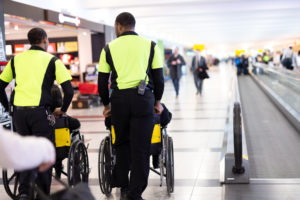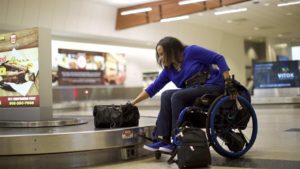Air Travel and Accessibility
Written by Mackenzie Saunders:
For people with spinal cord injuries and other disabilities, air travel can be an extremely difficult experience. At airports, people with disabilities often encounter problems such as damaged wheelchairs and not being fully accommodated by airlines during travel. Thankfully, the International Air Transport Association (IATA) took action in 2019 to make air travel more accessible for people with disabilities.
Resolution on Passengers with Disabilities

On June 2nd, 2019, the International Air Transport Association held the IATA Annual General Meeting in Seoul, where they unanimously passed the Resolution on Passengers with Disabilities.
This resolution is a set of standards aiming to improve air travel for people with disabilities.
This resolution focuses on four main aspects of accessibility in air travel: universal accessibility in airports and airplanes; clarity of international disability legislation; quality assistance of those with disabilities in airports; and coordination between governments and air travel organizations.
Universal accessibility means promoting inclusiveness for all passengers, including passengers with spinal cord injuries and other disabilities. Inclusivity means accessible physical structures in airports and airplanes such as ramps and wide aisles. Clarity of international disability legislation focuses specifically on establishing a common, universal definition for passengers with disabilities that will be used to guide international aviation standards. A clear definition for disability under air travel standards will ensure the full inclusion of every passenger with a disability in need of accommodations. The Resolution on Passengers with Disabilities also outlines quality assistance by air travel employees for disabled passengers. Quality assistance includes requiring thorough trainings for air travel employees to ensure that all employees can provide seamless assistance to disabled passengers. Lastly, the IATA will enforce the coordination between governments and air travel organizations to develop and execute accessibility standards. Governments and aviation organizations will be encouraged to collaborate to create the best possible solutions to air travel accessibility issues for people with spinal cord injuries and other disabilities.
 Why Air Travel Accessibility Standards Must Improve
Why Air Travel Accessibility Standards Must Improve
Improving standards for international air travel will be incredibly beneficial for the spinal cord injury and disability community, and this Resolution for Passengers with Disabilities takes a large step towards this necessary reform. The main benefit of this resolution is that people with disabilities will feel more comfortable during air travel. As people with disabilities feel more comfortable traveling by plane, they will be encouraged to travel more; traveling can increase people’s chances for recreation and relaxation, and ultimately increase one’s quality of life.
Contact the Spinal Cord Injury Law Firm
Although steps are being taken to make air travel more accessible for those with disabilities, problems while traveling with a disability can still occur. If you or a loved one encounter accessibility issues during air travel, please contact The Spinal Cord Injury Law Firm today at 1-877-SCI-FIRM. We are committed to defending the rights of accessibility for people with spinal cord injuries and other disabilities across the nation.


 Why Air Travel Accessibility Standards Must Improve
Why Air Travel Accessibility Standards Must Improve